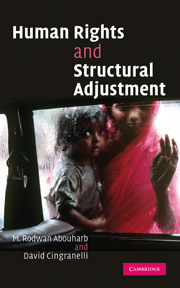Book contents
- Frontmatter
- Contents
- List of figures
- List of tables
- Acknowledgments
- Part I The argument
- Part II Estimating the human rights effects of structural adjustment
- Part III Findings
- 6 Economic and social rights
- 7 Civil conflict: demonstrations, riots, and rebellion
- 8 Torture, murder, disappearance, and political imprisonment
- 9 Worker rights
- 10 Democracy and civil liberties
- Part IV Conclusion
- Bibliography
- Author index
- Subject index
8 - Torture, murder, disappearance, and political imprisonment
Published online by Cambridge University Press: 30 June 2009
- Frontmatter
- Contents
- List of figures
- List of tables
- Acknowledgments
- Part I The argument
- Part II Estimating the human rights effects of structural adjustment
- Part III Findings
- 6 Economic and social rights
- 7 Civil conflict: demonstrations, riots, and rebellion
- 8 Torture, murder, disappearance, and political imprisonment
- 9 Worker rights
- 10 Democracy and civil liberties
- Part IV Conclusion
- Bibliography
- Author index
- Subject index
Summary
Introduction
Dramatic scenes of anti-government protest and rioting, which were met with acts of government-sponsored repression, took place across Morocco in the summer of 1981. These protests and the government's violent response came in the midst of an economic slump caused by lower levels of international demand for phosphates, fruits, and vegetables, Morocco's main exports (Paul 1981: 30). The bleak economic situation was worsened by austerity measures imposed by the International Monetary Fund, which called for the removal of food price subsidies and cuts in government spending (Paul 1981: 30). Paul (1981) describes in detail the violent repercussions of government-spending reductions which led to spontaneous demonstrations. Many students responded to reductions in education funding mandated by the IMF with rioting. The government responded to this first round of action with arrests of members of the former communist party and socialist parties in Morocco. Demonstrators were arrested and brought to trial for “endangering public order.”
Organized labor responded to the removal of price controls with calls for action. The Moroccan Trade Union Confederation called for a strike, which turned out to be very successful. The effect of this strike almost entirely shut down Morocco's largest city, Casablanca. Two days after this strike union leaders asked all citizens to join the protest. Demonstrators poured into the streets in all parts of the country, turning over buses, smashing cars and windows, setting things on fire, often targeting banks in the process.
- Type
- Chapter
- Information
- Human Rights and Structural Adjustment , pp. 170 - 182Publisher: Cambridge University PressPrint publication year: 2007



